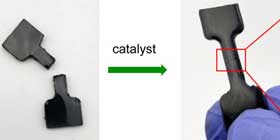
Australian researchers have developed a new kind of rubber and catalyst combo that can be used with low energy consumption to make flexible, repairable, sustainable rubber-based products that will last longer and reduce the need for recycling – including tyres. “This study reveals a new concept in the repair, adhesion and recycling of sustainable rubber,” says Associate Professor Justin Chalker of Flinders University (Flinders) in Adelaide, Australia.
The new rubber polymer is made from cheap industrial waste products such as sulphur, canola cooking oil and dicyclopentadiene (DCPD) from petroleum refining. The new material can be completely self-repaired and returned to its original strength – within minutes and at room temperature – with an amine catalyst. It is also resistant to water and corrosion.
According to researchers at Flinders, who teamed up with colleagues from the University of Western Australia and the University of Liverpool, England, said the new type of rubber can be used as a “latent adhesive.”
“The rubber is not ‘sticky’ until the amine catalyst is applied – it bonds to itself when the catalyst is applied to the surface. The adhesion is stronger than many commercial types of glue,” said researcher Dr. Tom Hasell from the University of Liverpool.
“It is exciting to see how the underlying chemistry of these materials can help with recycling, next-generation adhesives, and additive manufacturing,” Associate Professor Chalker added.
